The European Medieval world facilitated a cultural hegemony of a sort. Slowly at least, polytheistic traditions of various European groups were replaced with monotheism. Not rarely, this was by force, as in Charlemagne’s campaigns in which he killed “pagans” unwilling to convert to Catholicism. By the time Aquinas was writing Europe was Catholic, though with the splintering of the Orthodox churches and a small percentage of Jews and Muslims.
Like the traditional forms of government in Ancient Greece and Ancient Rome, the Medieval World also did not have a clear separation of religion and politics. Whatever the impact of the two swords doctrine — based on Jesus’ injunction in the Gospel narrative and practical considerations the one should “Give to Caesar what belongs to Caesar but give to God what belongs to God” — one’s civic duty implied a religious duty. Aquinas, building on Aristotle, saw the role of the state as being to facilitate human flourishing. But with his added focus on not only natural but also supra-natural goods, this also meant that the state was to facilitate right religious belief. Indeed, one’s ultimate well-being, in the afterlife, was dependent on this. Yet given the disagreements about what right belief consisted in and the not just occasional ability to use religious belief as a foil for other interests, this role of the state resulted in much political suppression, violence and war. Beautiful sounding ideas sometimes live out very badly.
After the emergence of Protestantism (1517), bloody wars were increasingly waged for political and material power as well as the hearts and minds of men. Religious wars occurred in France, Scandinavia, Great Britain and Ireland, to name but a few. In the 30 Years War (1619-1648), one of the bloodiest, about eight million people were killed and one-fifth of the population of Germany. It resulted in the Peace of Westphalia, according to which each prince could freely decide the religion of his princedom. Yet the newly formed Protestant churches, like the Catholic church, held a tight reign over the intellectual and political life of the regions in which they became dominant.
Religious upheaval was just one of the characteristics of the Renaissance (from about 1400 to 1600). It was born with a renewed focus on humanism. Scholars of this period returned to many of the early Roman authors, again emphasized the value of everyday lives, which resulted in a renewed emphasis on “vocations” beyond those of Catholic clericalism.
As the infrastructure of Europe was strengthened and material wealth increased on the Continent in this period, eventually freedoms of thought were desired that superseded those of religion. In the seventeenth century, Europe entered the Enlightenment, a period of increasing focus on individual freedoms. The Enlightenment is known for the scientific revolution born of it and for politics highlighting individual rights and increasingly favoring democratic forms of rule. The major ideals of the contemporary cultural and political world were spawned in this period. Among other things, the basic rights discussed increasingly came to include the freedom of religion. John Locke’s calls for religious toleration were among the first indicating that the toll of religious war was simply too high. In the hands of the American thinker Roger Williams, the idea is given even clearer expression: individuals, not just princes, should have a right to believe whatever religious ideas they would like. Regardless of whether one agreed, as Aristotelians and Thomists had, that the state had a role of helping individuals secure their fundamental well-being, there was a new found difference in view about what that well-being consisted in. The state would no longer be seen as responsible for ensuring religious orthodoxy. Instead, it was increasingly thought that it could better protect individual well-being by protecting the individual right of conscience.
In my next post I will discuss in more detail some of the overarching characteristics of the Enlightenment. I will continue to look at it impacts and begin to discuss the views of some of the heaviest critics of the Enlightenment.
Go to Chapter 16, The Enlightenment.
